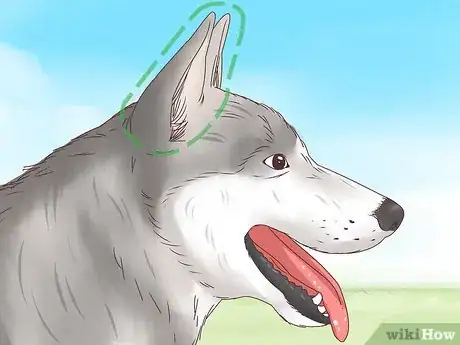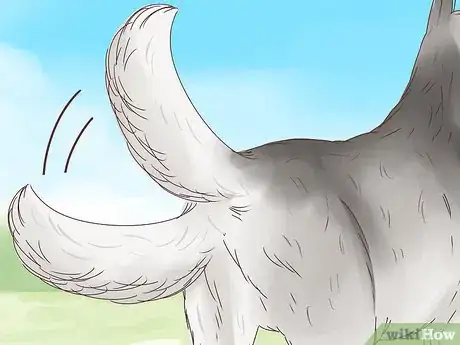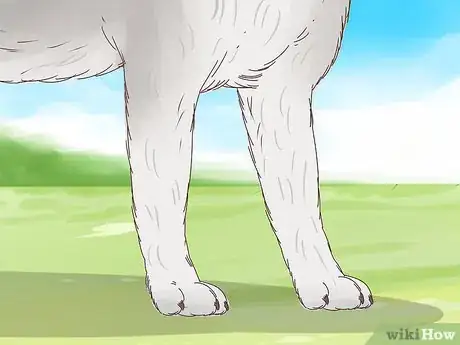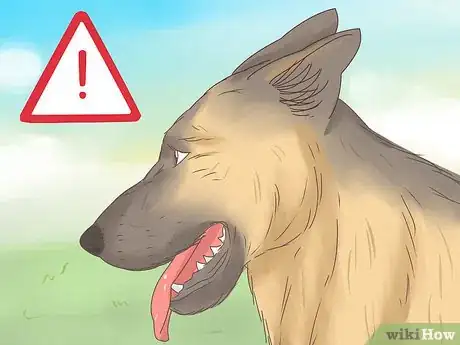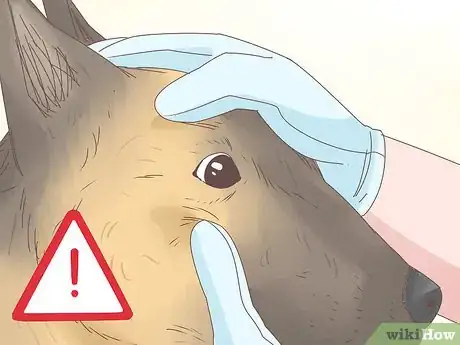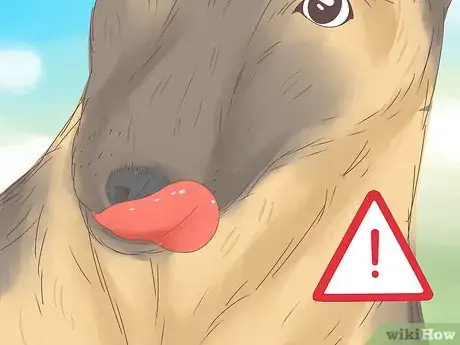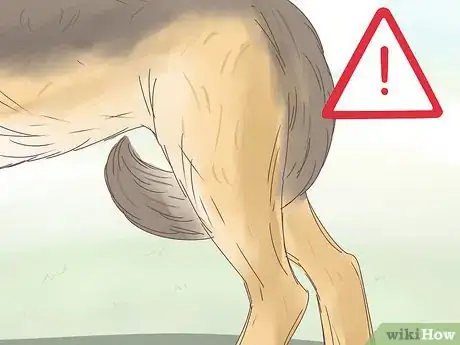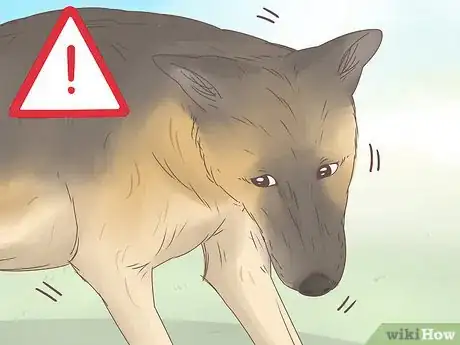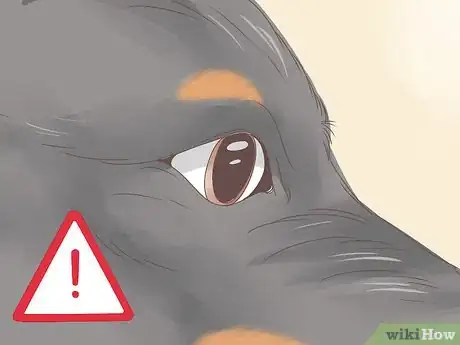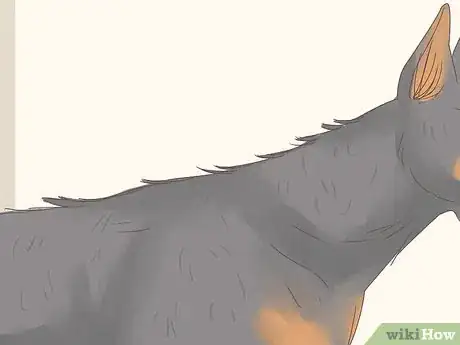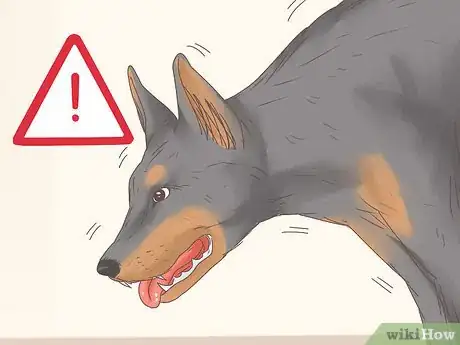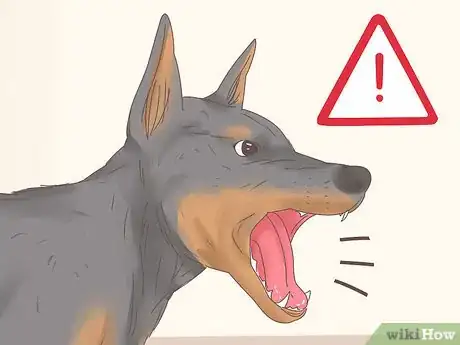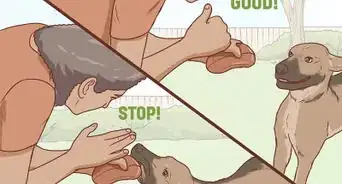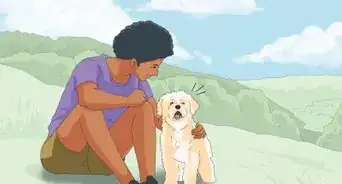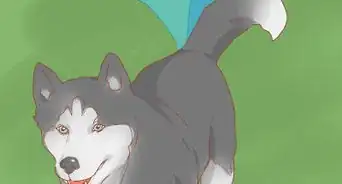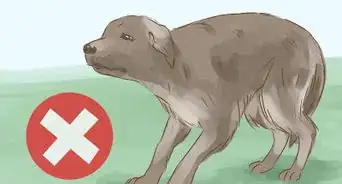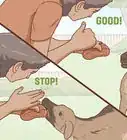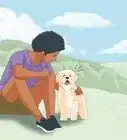This article was co-authored by Sheri Williams. Sheri Williams is a Certified Dog Trainer and Behaviorist and the Owner of sheriwilliams.com, a business that specializes in teaching veterans how to turn their dogs into service dogs or emotional support animals to assist with PTSD. Based in the Los Angeles, California metro area, Sheri has over 20 years of dog training experience and also runs a general dog training practice specializing in rehabilitating dogs through positive reinforcement training techniques. She is certified by The Animal Behavior and Training Association.
This article has been viewed 94,201 times.
A dog’s body can tell you a lot about what they’re feeling, whether that is relaxed, playful, anxious, or even aggressive. By learning how to recognize your dog’s body language, you can better understand them and their world. Always check your dog’s ears, eyes, mouth, tail, and body for insight into how they’re feeling.
Steps
Identifying Relaxed or Playful Body Language
-
1Look for ears that are up rather than laid back or pointing forward. When you are near a dog, check their ear positioning. If their ears are upright, that means that they are relaxed and aware of their surroundings, but they don’t feel anxious, aggressive, or overly-excited. Similarly, if your dog cocks their head to the side while their ears are upright, this means they are trying to understand you or their surroundings.[1]
- You can tell how your dog is feeling if they have floppy ears, too. Just check the base of their ears to see which direction they’re pointing.
-
2Check the dog’s tail for wagging and waving about. A relaxed or playful dog will have a tail that is either wagging back and forth lightly, or a tail that is energetically waving back and forth, just depending on their excitement level. The main thing to watch for is that the actual tail bone remains relaxed. When it stiffens or straightens out from their body, this could mean they’re feeling aggressive or overly-alert.[2]
- If your dog's tail is stiff, low, and slowly wagging, this could be a sign of aggression. Monitor your dog carefully if you notice this.
- Even though there are similarities among all dogs and their body language, each individual dog can act uniquely. Pay attention to your dog’s tail during times when you know they are relaxed or playful. This will give you a baseline for what your dog’s “normal” is.
Advertisement -
3Watch for a loose stance to indicate that the dog is feeling relaxed. If your dog is standing with their front paws slightly apart, rather than locked and in a forward position, this means they are feeling relaxed. Also, if your dog feels comfortable, they won’t hesitate to sit or lay down where they are if they want to, rather than being on guard.[3]
- If your dog is laying down, a frog-legged splay, a roll to the side, or a roll onto their belly indicates that they are very relaxed.
-
4Pay attention to your dog if they lower their chest but keep their rear up. This is a classic, “I’m ready to play!” sign. The dog will lower their front half while often wiggling their behind in the air. They may only hold this position for a few seconds before bounding off in one direction or another. If you can, reward this playful behavior with a few minutes of play or even a quick walk around the block.[4]
- Your dog may growl or bark while in this position, but their body language indicates this is done in a playful spirit. An aggressive dog would not be in this position.
-
5Play with your dog when they bring you toys. If your dog continually brings you toys or items they love, like socks or blankets, this means they are friendly and looking for some attention. Chances are, if you play with them for a while, they will calm down and relax for a few hours afterwards.[5]
- Your dog may also bring you items if they think you are sad because they think it’ll cheer you up.
Spotting Anxious or Angry Movements
-
1Observe if the dog’s ears are laid back on their head. Ears are a great indicator of how your dog is feeling. If the dog’s ears are laid back flat against their head, this means they are feeling scared, anxious, or unsettled.[6] Check the surroundings to see what could be causing their anxiety. If you can, alleviate the situation or use calming language to assure your dog of their safety.[7]
- Your dog may also avert their gaze or glance back and forth at you quickly if they are feeling anxious. This, coupled with the backwards ears, shows that there is something wrong in your dog’s world.
-
2Examine your dog’s eyes to see if they are dilated. When a dog becomes fearful, their eyes will widen, as will their pupils.[8] You’ll often be able to see the whites of their eyes. If this happens, it means that they are over-alert and are trying to see everything around them at once.[9]
- It’s often helpful to provide a “safe space” for your dog, especially in your home. A crate, a blanket, or a special corner of the couch may be a great place for your dog to retreat to when they’re feeling anxious.
-
3Check if your dog is licking their mouth repeatedly. Any kind of repetitive behavior, like licking, panting, or salivating, when there is no obvious catalyst for the behavior, is a sign of anxiety. If your dog hasn’t just eaten and they are constantly licking around their mouth, this means they aren’t feeling safe. Observe the surroundings to see if there is anything you can do to help them feel better.[10]
- A dog who licks their paw or leg repeatedly is also often showing signs of anxiety. Repetitive licking can be a self-soothing behavior when the dog doesn’t know if it should flee or fight.
-
4Look to see if the dog’s tail is tucked and still. If the tail bone is down and pointing between your dog’s legs, this is an indication of anxiety. Anxious dogs may still sometimes wag their tails, though the tail bone will still be pointing down and the wag will be low and slow.[11]
- The best way to learn to read your dog’s tail is to observe what your dog does in situations where they aren’t stressed. This way, you’ll be able to notice abnormal behavior when it occurs.
-
5Watch your dog to see if they are visibly shaking or whining anxiously. Loud noises like thunder or fireworks can be upsetting to dogs and often cause them to visibly shake. When you see this behavior, be aware that something is upsetting your dog. If you can, help them feel safe by letting them hide or by doing something to drown out the offending noise.[12]
- There are special products made for dogs that are meant to help them withstand the sounds of thunder and fireworks. Check them out if you think they might be helpful for your dog.
- If there is a storm outside, close the windows and blinds, and take your dog to an interior room that is further away from the outside.
Recognizing Aggressive Behavior
-
1Watch your dog’s mouth for snarling and an excessive showing of teeth.[13] While your dog may show their teeth sometimes while they are playing, if their lips are curled back and you can see their gums, this is a clear indication that they feel aggressive. If you can, take a few steps back from the dog to give them space and observe what is making them upset.[14]
- Many dogs get territorial when it comes to food, treats, or toys. It’s possible you stepped to close to them for comfort.
-
2Look for a wrinkled muzzle to tell if your dog is feeling aggressive. If your dog is wrinkling the area between their nose and eyes, this is another sign they are upset. It’s a good indication that their behavior is bordering on aggressive rather than playful.[15]
- Always err on the side of caution when your dog behaves aggressively. If you have other animals or children, make sure to keep them away from the aggravated dog.
-
3Check your dog’s fur to see if their hackles are raised. Look at your dog’s hind section. If the hair is raised up rather than laying flat, this means they are on guard and ready to fight. Always check to see what your dog is responding to and do what you can to alleviate the situation, but definitely put your own safety first.[16]
- Don’t try to just brush your dog’s hair back down. This won’t do anything to alleviate the way they’re feeling and may just upset them more.
-
4Look to see if your dog freezes with their head lowered. This can often indicate that they are guarding something they don’t want you (or another dog) to have. If their front legs are stiff and their head is slanted downward in a locked position, this means they are feeling very unhappy about something.[17]
- If your dog has a hold of something that could be harmful to them, try to distract them with a treat or favorite toy to get them to abandon the item they’re guarding.
-
5Listen to your dog to hear if they are barking or growling.[18] This is often a great indicator of your dog’s feelings. While dogs bark for many reasons, a bark or growl coupled with other indicators of aggressive behavior can help clue you in to what your dog is feeling. Check the direction in which your dog is barking to see if you can locate the cause. This may help you avoid similar situations in the future.[19]
- If you have trouble getting your dog to stop barking, or if they’re having any other behavioral issues, you may want to take them to dog-training classes.
Expert Q&A
Did you know you can get expert answers for this article?
Unlock expert answers by supporting wikiHow
-
QuestionHow can I tell what mood my dog is in?
 Sheri WilliamsSheri Williams is a Certified Dog Trainer and Behaviorist and the Owner of sheriwilliams.com, a business that specializes in teaching veterans how to turn their dogs into service dogs or emotional support animals to assist with PTSD. Based in the Los Angeles, California metro area, Sheri has over 20 years of dog training experience and also runs a general dog training practice specializing in rehabilitating dogs through positive reinforcement training techniques. She is certified by The Animal Behavior and Training Association.
Sheri WilliamsSheri Williams is a Certified Dog Trainer and Behaviorist and the Owner of sheriwilliams.com, a business that specializes in teaching veterans how to turn their dogs into service dogs or emotional support animals to assist with PTSD. Based in the Los Angeles, California metro area, Sheri has over 20 years of dog training experience and also runs a general dog training practice specializing in rehabilitating dogs through positive reinforcement training techniques. She is certified by The Animal Behavior and Training Association.
Certified Dog Trainer
-
QuestionWhat does it mean when my dog runs away from me to my spouse when I come near her?
 Community AnswerIt could mean a variety of things. Maybe your demeanor is frightening the dog, or they just prefer your spouse to you in that moment. If you have punished the dog in the past, it's possible that they are scared of you, in which case you should work on spending time and bonding with the dog to regain their trust.
Community AnswerIt could mean a variety of things. Maybe your demeanor is frightening the dog, or they just prefer your spouse to you in that moment. If you have punished the dog in the past, it's possible that they are scared of you, in which case you should work on spending time and bonding with the dog to regain their trust. -
QuestionWhat does it mean when a dog licks my arms and legs?
 Community Answerit can mean a veriety of things. She may be bored, trying to dominate you or just showing affection. She may also just like the way your skin tastes.
Community Answerit can mean a veriety of things. She may be bored, trying to dominate you or just showing affection. She may also just like the way your skin tastes.
References
- ↑ https://moderndogmagazine.com/articles/how-read-your-dogs-body-language/415
- ↑ https://www.aspcapro.org/resource/7-tips-canine-body-language
- ↑ https://www.aspcapro.org/resource/7-tips-canine-body-language
- ↑ https://moderndogmagazine.com/articles/how-read-your-dogs-body-language/415
- ↑ https://bestfriends.org/resources/dog-body-language
- ↑ Sheri Williams. Certified Dog Trainer. Expert Interview. 5 June 2020.
- ↑ https://www.aspcapro.org/resource/7-tips-canine-body-language
- ↑ Sheri Williams. Certified Dog Trainer. Expert Interview. 5 June 2020.
- ↑ https://www.aspcapro.org/resource/7-tips-canine-body-language
- ↑ https://bestfriends.org/resources/dog-body-language
- ↑ https://moderndogmagazine.com/articles/how-read-your-dogs-body-language/415
- ↑ https://moderndogmagazine.com/articles/how-read-your-dogs-body-language/415
- ↑ Sheri Williams. Certified Dog Trainer. Expert Interview. 5 June 2020.
- ↑ https://moderndogmagazine.com/articles/how-read-your-dogs-body-language/415
- ↑ https://www.aspcapro.org/resource/7-tips-canine-body-language
- ↑ https://moderndogmagazine.com/articles/how-read-your-dogs-body-language/415
- ↑ https://bestfriends.org/resources/dog-body-language
- ↑ Sheri Williams. Certified Dog Trainer. Expert Interview. 5 June 2020.
- ↑ https://centerforshelterdogs.tufts.edu/dog-behavior/dog-communication-and-body-language/
About This Article
To understand your dog's body language, start by checking the dog's ear positioning. Upright ears indicate that a dog feels relaxed, but ears that are laid back flat indicate fear or anxiety. If the dog is wagging its tail, it's happy, but if the tail is tucked and still, the dog may feel stressed or anxious. If the dog lowers its chest but keeps its rear up, this usually means it's ready to play, but a wrinkled muzzle indicates aggression. For tips on understanding eye and mouth movements, read on!
